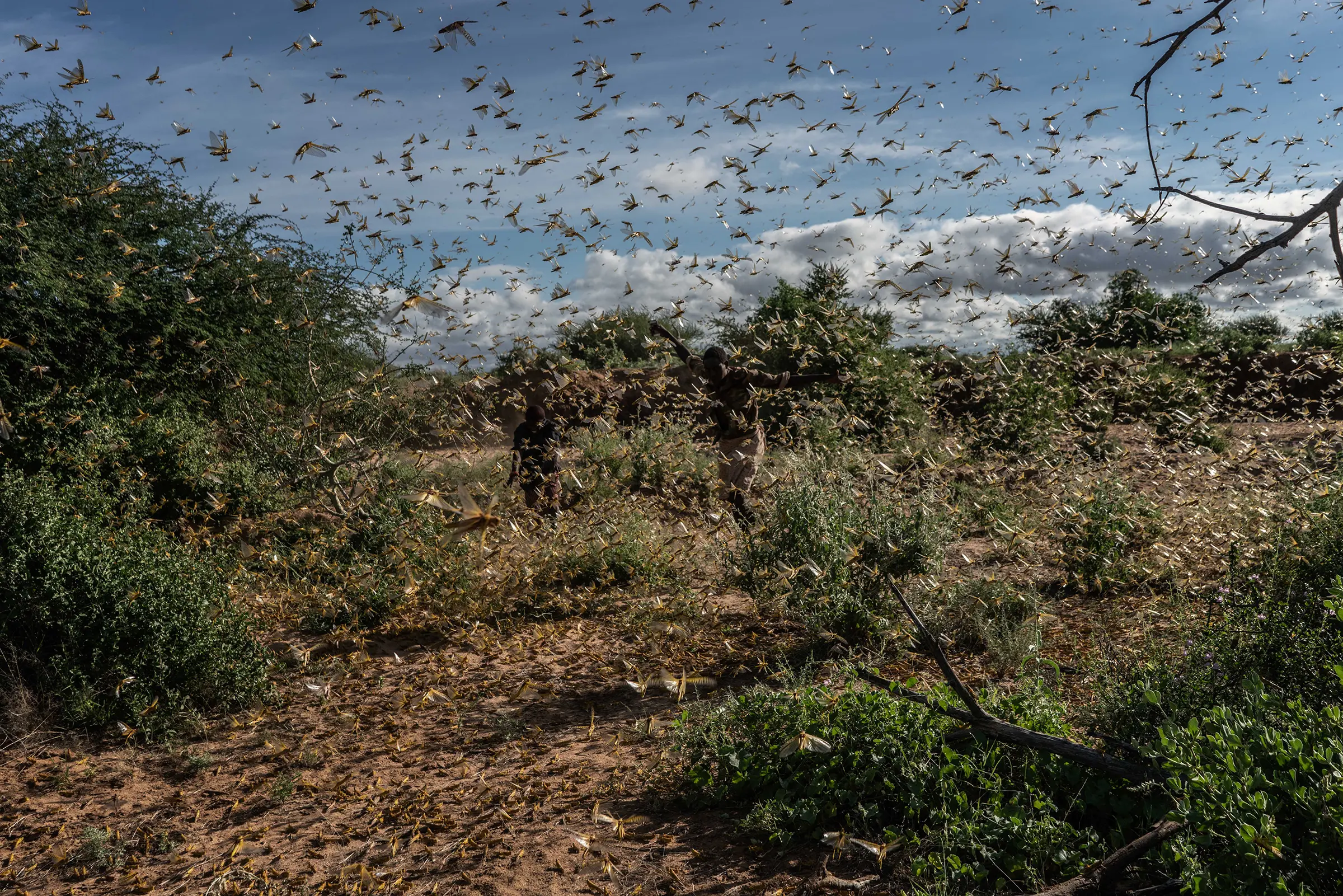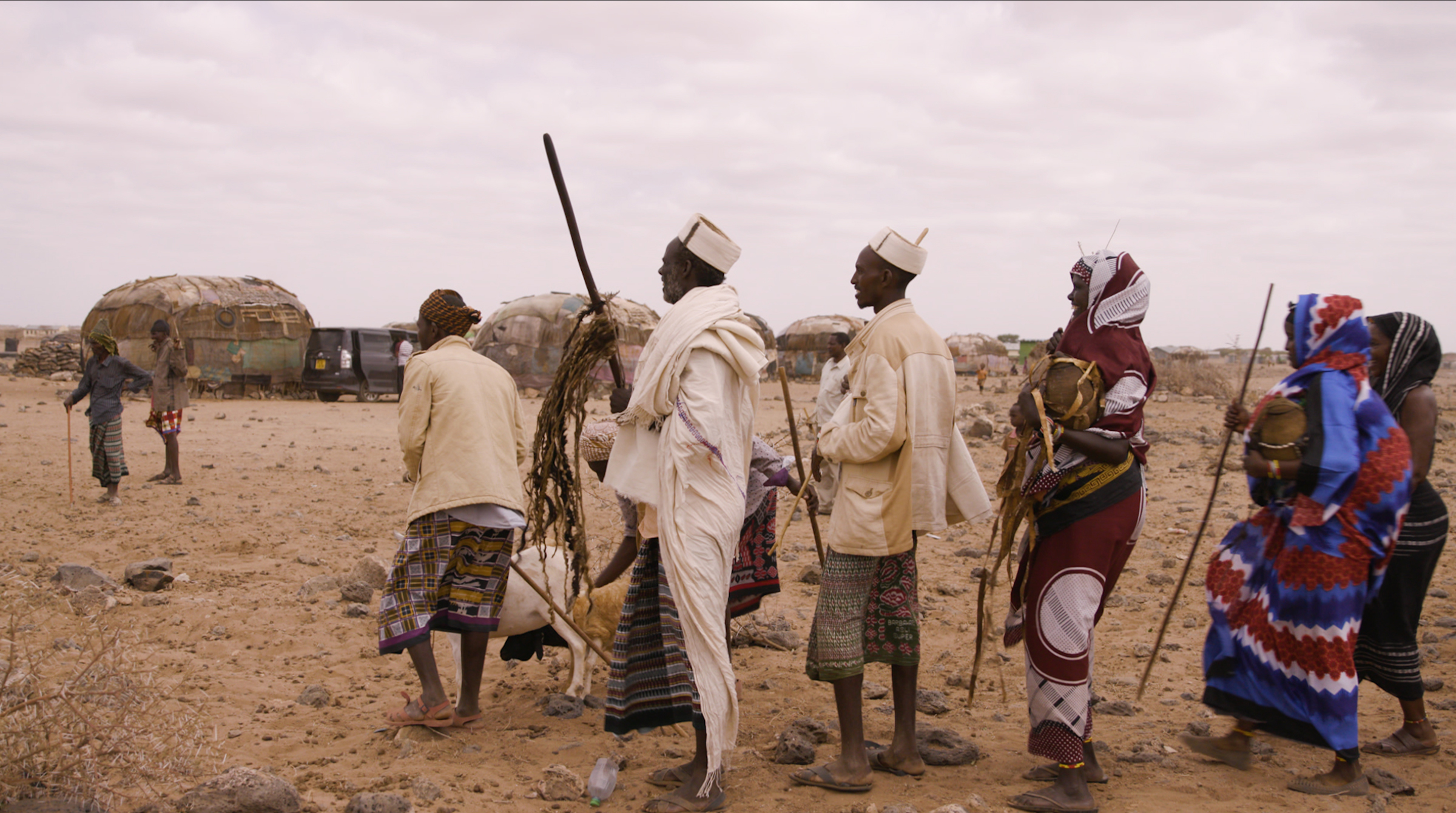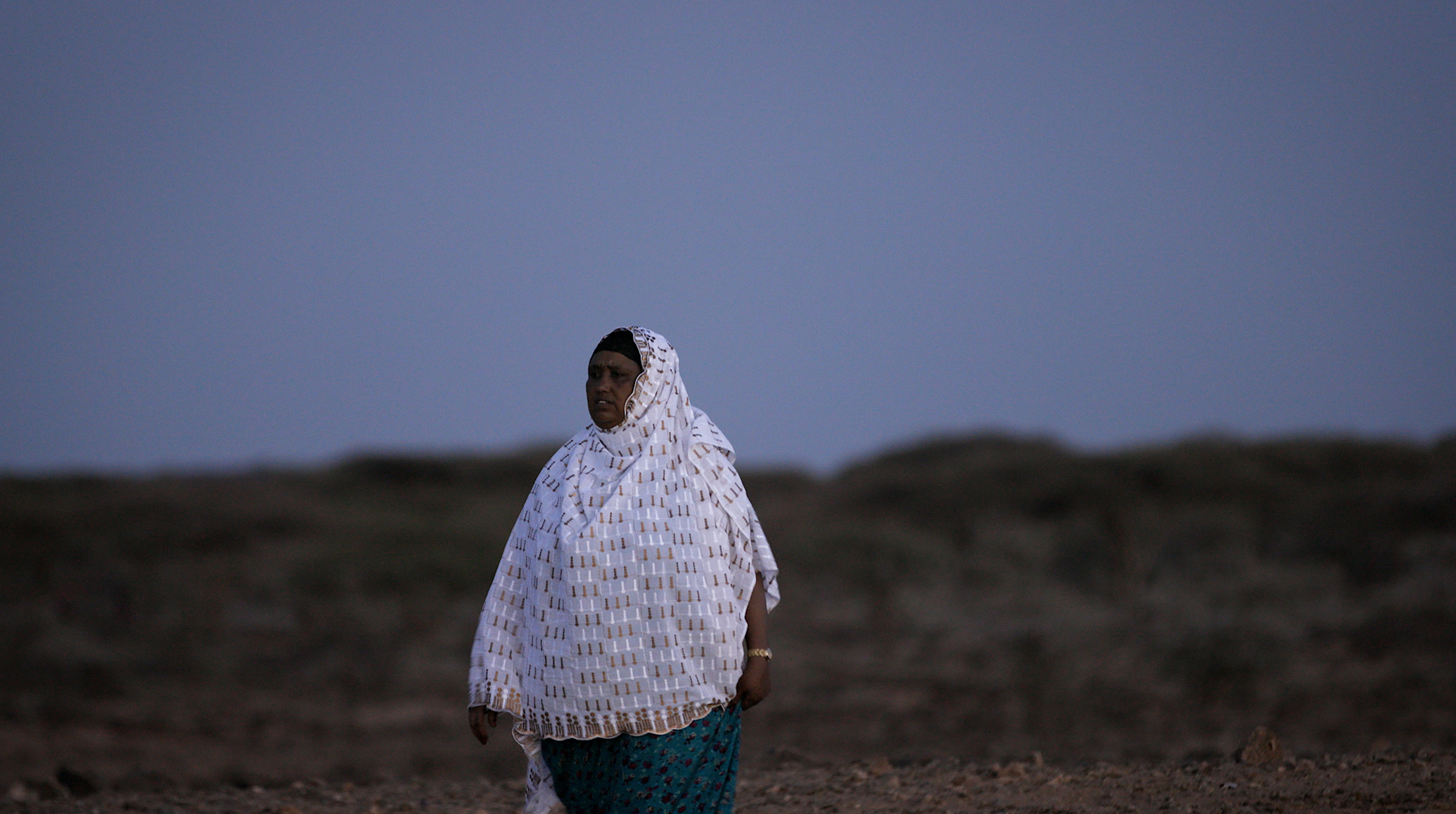Reporting for this article was supported by a grant from The Pulitzer Center on Crisis Reporting.
In a small hut in the village of Bubisa, a young bride named Tunne sits alone on a makeshift pallet bed. Smoke from a smoldering indoor cook fire stings the eyes and obscures the air, and a single beam of sunlight streams in through a tiny hole in the wall that passes for a window. Tunne, who normally wears the loose, cotton dira dress customary for girls in this region, is today wrapped head to toe in traditional, azure-colored wedding fabric, still stiff from its newness. Her neck is adorned with red and yellow beads.
It’s March 13, and the Gabra tribe of north-east Kenya is about to begin its annual, three-day mass-marriage ceremony. Across the region, hundreds of couples will be married during a single auspicious weekend of celebration. In Bubisa—a village without a gas station or grocery store that sits about 30 miles north of Marsabit, the nearest developed town, and 360 miles north of Nairobi, the nation’s capital—families erect tents and set up sound systems as the festivities kick-off.
Through the shawl that covers her mouth, Tunne tells me she is 17 years old. But her father has said she’s 16, and Nuria Gollo, a local activist fighting against child marriage—who introduced me to the young bride—told me she is 15. Tunne’s childish voice and small stature suggest Gollo is probably right.
No matter which number is accurate, Tunne is, by law, a child, and child marriage has been prohibited in Kenya since 1990, when the country ratified the Convention on the Rights of the Child, a United Nations human rights treaty between nations to protect children from a number of abuses. Additional Kenyan laws, including the Children’s Act of 2001, the Sexual Offences Act of 2006 and the Marriage Act of 2014 (which explicitly prohibits the marriage of children under 18), further criminalized this practice. In 2013, Kenya’s Ministers of Health and Education committed, along with Ministers from several other African nations, to ending child marriage by the end of 2020. Kenya’s efforts have worked to some extent: the share of young women between 20 and 24 years of age who were married before their 18th birthday dropped from 34% in 1994 to 23% in 2016, the most recent year for which accurate data are available. But the target date of 2020 for completely eliminating child marriage is fast approaching, and the country is still far from meeting that goal.
In part, that’s because of climate change, which have given rise to a resurgence of child marriage in northern Kenya in the last five years, experts say. Here, increasingly frequent droughts and a plague of locusts linked to climate change have depleted water and grazeland, and the livestock that are the economic backbone of pastoralist communities like Bubisa are dying of hunger, thirst and disease. To cope, desperate families are increasingly pulling their daughters from school and marrying them off in exchange for dowries—typically comprised of new clothes, drums of fresh milk and several camels. (Camels are highly valued for their milk and meat, and their use in transporting people and goods across long distances in Kenya’s northern desert land.)

While there aren’t widely agreed-upon figures, a growing body of research suggests that climate change is increasingly putting more girls at risk of being married off at a young age. For example, a January 2020 report released by the International Union for Conservation of Nature and the United States Agency for International Development and a June 2020 report released by the United Nations Population Fund (UNFPA) found that globally, dowry practices are exacerbated in times of crisis and displacement, such as drought, and contribute to higher prevalence of child marriage. Mohamed Abdullahi, the head of the United Nations International Children’s Fund Kenya’s northeast office, says that cases of child marriage have increased in the country as a result of “man-made and natural disasters, specifically drought.”
Kenya has been trying to fight back; in recent months, the federal government has tasked local law enforcement and officials with cracking down on the practice. So, as the celebrations in Bubisa commence, police slowly make their way from tent to tent, checking on the age of each bride-to-be. But many of the local officials and police come from the same tribes as the families of the brides and grooms, Gollo explains, which means some will turn a blind eye to child marriages.
During the course of my reporting, Tunne and her family seem to conceal her real age. But even then, they do not tell me she is 18; Tunne looks so young that this would be difficult to believe. Rather, they place her age around 16 or 17, still below the legal limit, but a more realistic approximation that Gollo says they believe they can get away with without trouble from the authorities.
Compared to the rest of the world, Kenya sits fairly high in the ranks of countries most likely to feel significant impacts of climate change. In 2018, the University of Notre Dame’s Global Adaptation Initiative Index ranked Kenya 36th among all countries in vulnerability to climate change effects—and 152nd in terms of preparedness to deal with these effects.
Kenya’s mean annual temperature has been increasing at a rate of 0.34°C per decade over the last 30 years. The country has two rainy seasons: the long rains, which typically last from April until early June, and the short rains, which intermittently come from November through December. In recent years, during these seasons, precipitation has become more intense and less predictable, causing an increase in dangerous flash floods. But it is the droughts during the dry seasons that have had the greatest economic impact in Kenya, and the most profound effect on families like Tunne’s. Kenya experienced nine droughts between 1950 and 2000. In the 20 years since then, it has already counted at least six.
Prolonged droughts have plagued Bubisa in six of the last 10 years. In 2010-2011, the region suffered what many called the worst in 60 years, decimating the livestock of North Kenyans, who have struggled to recover in the aftermath. Subsequent droughts in 2015-2016 and 2017-2018 exacerbated the problem, creating an existential crisis for many pastoralists in the region. An estimated 30% of Kenyan livestock owners were forced to find new sources of income between 1997 and 2017, according to a 2017 report from Kenya’s Ministry of Agriculture, Livestock and Fisheries. And the World Bank estimates that droughts caused some $1.08 billion in losses due to their impact on Kenya’s livestock populations between 2007 and 2017.

This year, the skies finally opened up in March, bringing above-average rainfall to many parts of the country. But the rain came too hard, too fast, creating flash floods that washed away the seeds pastoralists in the region had recently planted in the hopes of regenerating pasturelands to feed their hungry animals. Instead, to survive, families were forced to make difficult decisions, like which children they should pull out of school to herd their animals, and whether to sell any unmarried daughters off for dowry.
Though climate change affects every human on Earth, it is likely to harm young girls more than any other age or gender demographic, says Dr. Mary Nyasimi, director of Inclusive Climate Change Adaptation for a Sustainable Africa, a Kenya-based nonprofit supported by donors including the African Development Bank Group and GIZ, an international development agency based in Germany. In large part, that’s because of deeply ingrained gender disparities all over the world, although these play out in different ways across cultures.
Many of northern Kenya’s traditionalist pastoralist communities, for example, tend to be deeply patriarchal. Boys are the only ones allowed to be financial providers and to make decisions, and as a result, families value them more than girls. Girls, on the other hand, are often seen purely in terms of the dowry money they can bring in. So, in times of economic hardship, families usually pull girls out of school before boys. While Kenya does offer free public schooling, the cost of transportation to and from school, uniforms and even books and pencils can be prohibitive for many families. “Whatever little they have, they would rather use it to educate the boy rather than educate the girl,” says Halima Aden, who runs a girls’ school in Marsabit county.
During the drought of 2016, Tunne’s parents pulled her out of school and tasked her with herding the animals while her brothers continued to get an education. But things only worsened as the region continued to suffer droughts year after year. Many of Tunne’s family’s goats and camels died over the years, and even more had to be sold for the family to survive. So, when a wealthy family in the village came to Tunne’s father asking for his daughter’s hand in marriage for their 23-year-old son—offering a dowry of three camels, which locals say can be sold at up to $700 per head—it was an offer too good to refuse.
When I ask Tunne if she had a choice in her marriage, she nods yes. But later in our interview, I inquire if she’s looking forward to the wedding. She is not, she says, but felt she couldn’t refuse her father’s wishes. “At that tender age the girl does not have a voice,” Aden says. “That deliberation is made by the parents, and the girl will not say no to the parents.”
Nuria Gollo sits on the board of the Kenyan government’s National Council for Children’s Services and is a local activist in the northern part of the country. Her mother is a member of the Gabra tribe and Gollo knows all too well the physical and emotional toll that early marriage takes on the girl child; she was married off by her father when she was only 16. Gollo wanted to work as a teacher, but her new husband would not permit it. So, two years later, she ran away, staying with supportive friends who helped her survive. Her parents were mortified that their daughter had abandoned her marriage, and for some time Gollo had “a bad relationship” with them, never visiting her childhood home.
Eventually, Gollo was able to fulfill her dream, finding work as a teacher. Six years after she left her marriage, her ex-husband remarried, and Gollo’s parents finally began accepting her choice. Gollo’s ex-husband eventually gave her a certificate of divorce, nearly 10 years after the marriage ended, but to this day, has not paid her the alimony stipulated in their Islamic wedding contract. Today, Gollo is married to a man she met nearly 15 years after that first marriage ended, and has dedicated her life to fighting child marriage. She has become well-known in the Marsabit region; she travels from village to village to rescue girls who are intended for marriage and bring them back to school. She intervenes with families, and, if necessary, escalates the cases to the local police station. She also works with the Kenyan government to establish rules, regulations and procedures for reducing rates of child marriage in northern communities.

“I have gone through [child marriage], and I know how painful it is,” says Gollo. “How it has deterred me from reaching my desired goals. And I wouldn’t like to sit and watch the same happening to the younger girls who are being married off.”
The June UNFPA report found that most child brides around the world leave school and immediately begin having children. They often have no choice in the matter: In Kenya, only 56% of women and girls make their own decisions about their sexual and reproductive health, including when to have children, and how many. Globally, girls who are married young face higher risks of pregnancy-related death due to early, poorly spaced, and too oft-repeated pregnancies and childbirth. Child brides are also more vulnerable to domestic violence, social isolation and depression.
But it is not only the child brides who suffer from the effects of early marriage: it’s economically detrimental to the country as a whole, because the practice prevents girls from attaining an education, and thus being able to contribute to the national workforce. A 2017 World Bank study found that if child marriage were eradicated, developing economies could save trillions of dollars by the year 2030.
Globally, an estimated 650 million girls and women alive today were married as children, and every single day, on average, some 33,000 underage girls are married off. The harm that child marriage causes to communities and entire nations is still being assessed, but as the effects of climate change continue to intensify around the world, girls like Tunne will be increasingly vulnerable to being married off young. Without intervention from governments, organizations and activists, many more young girls in countries across the world will be sold into marriage as global temperatures rise and extreme weather becomes more common.
Girls who are married early are also more likely to perpetuate stereotypical gender roles and to transmit these norms to their own children, according to the June 2020 UNFPA report. “If a girl drops out of school, and she goes back and lives the [same] life [her] mother has been living…in that community is not going to grow, and life is not going to be any better for anyone,” says Aden, who runs the girls’ school in Marsabit. “The vicious circle is going to continue.”
But some are trying to break that cycle. In Marsabit, 17-year-old Gumato Kunni leads me into the one-room home that she keeps spotlessly clean for her husband and two-year-old daughter, Rukia. She invites me to sit on the only available piece of furniture, a mattress on the floor.
“My parents married each other poor,” says Kunni. “Without any livestock, we did not have anything.” Eventually, the family, members of the Gabra tribe, did acquire a few animals, but they were still in need. “We used to borrow milk from our neighbors and other people who were close to us,” she says. As a child growing up in the remote village of Burgabo, deep in the Chalbi desert, Kunni was studious, and dreamed of becoming a schoolteacher and educating future generations of girls. The 2015 drought destroyed those dreams. One day that year, Kunni says, her father came back home empty-handed holding only his herding stick. The few animals the family owned had all died.
“When my marriage proposal came [two years later], I was married off,” she says. “My community sells off their children any time marriage proposals come forth.” Kunni’s 21-year-old husband is a truck driver—a good father and provider, she says. The couple moved about 60 miles south to Marsabit, hoping to provide Rukia with a better life than they had growing up. Kunni says the worst part about being married so young was missing out on her childhood, playing and having fun with her friends.
As we talk, she sings to Rukia, and tosses her up and down as the tiny girl squeals in delight. “I love my daughter so much,” Kunni tells me, her soft brown eyes lighting up. “I dream that her child gets educated, and that she helps her in the future, and [us] too.”
Correction, August 13
The original version of this story and video misstated Nuria Gollo’s tribe. Her mother is a member of the Gabra tribe, while she is a member of a different tribe.
More Must-Reads from TIME
- Cybersecurity Experts Are Sounding the Alarm on DOGE
- Meet the 2025 Women of the Year
- The Harsh Truth About Disability Inclusion
- Why Do More Young Adults Have Cancer?
- Colman Domingo Leads With Radical Love
- How to Get Better at Doing Things Alone
- Michelle Zauner Stares Down the Darkness
Contact us at letters@time.com